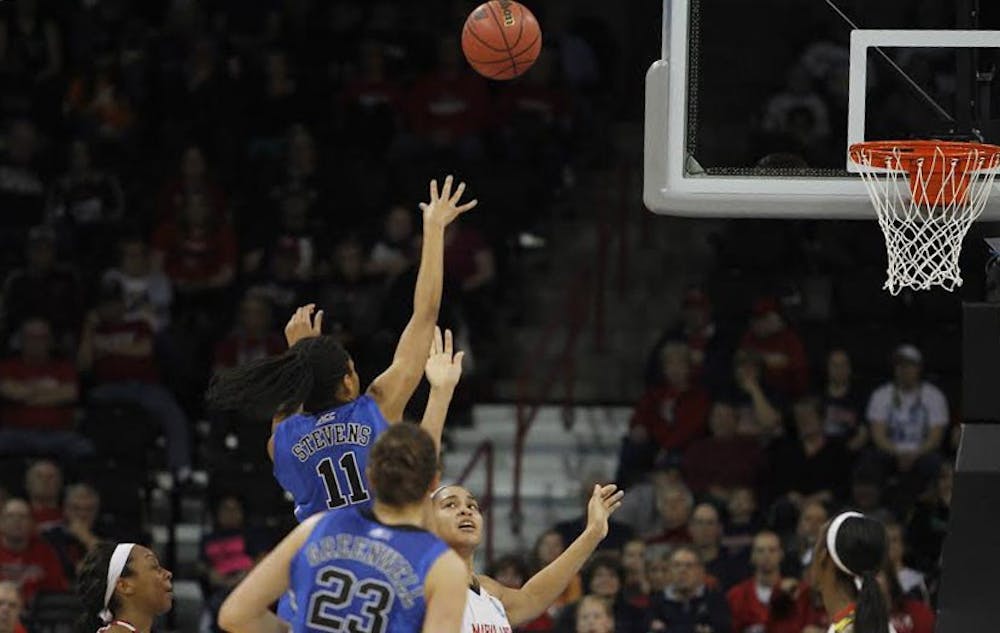As the tallest team in the nation, Duke's plethora of post players allowed the team to finish fourth in the nation in rebounding margin and continuously pound smaller opponents in the paint all season.
But Saturday afternoon in Spokane, Wash., the Blue Devils' size failed them.
Fourth-seeded Duke's season came to an end in the Sweet 16 with a 65-55 loss at the hands of top-seeded Maryland. The loss marked the end of All-American senior Elizabeth Williams’ illustrious career as well as four solid years of production from guard Ka’lia Johnson.
“I’m really proud of [Williams and Johnson], Duke head coach Joanne P. McCallie said. “It has been a remarkable season in many ways and what they’ve accomplished together as seniors is incredible. I would take them anywhere and I would take them in any fight”
In a matchup of size versus speed, the quickness of the Terrapins' guards left Duke’s bigs scrambling time and time again. After Laurin Mincy's 15 first-half points—on 4-of-5 shooting from beyond the arc—put the Blue Devils down by as many as 10 in the first half, Duke faced an uphill battle to get back into the game.
Duke responded out of the gates in the second half, forcing Maryland head coach Brenda Frese to burn a timeout to stem a rally. But even when the Blue Devils were able to trim the lead to 42-41 in the second half, the Terrapins' perimeter shooting proved to be just too much.
“Maryland did a tremendous job of being the aggressor in the first half and it set us back a little bit,” Johnson said. “We’ve been talking about playing a full 40 minutes all year and when you don’t, you don’t get the results you want.”
At the end of the day, it appears that Maryland was simply a bad matchup for Duke. The Blue Devils struggled for much of the year to defend the three—as evident in losses at Boston College and Notre Dame—due to the inability of their bigger players to close out effectively and Saturday was no exception.
When Duke zeroed in on Mincy in the second-half, both Shatori Walker-Kimbrough—who scored 18 points in the final 20 minutes—and Brene Moseley were able to continue Maryland’s onslaught from the perimeter.
“Duke was trying to make adjustments but we just kept playing our game,” Walker-Kimbrough said. “Coach told us that if we pass up an open shot, it’s a bad shot.”
For Blue Devils fans, the loss will certainly sting.
Duke had one of its best chances to reach the Final Four in the Elizabeth Williams-era with Connecticut and Notre Dame out of the Blue Devils’ region. But at the end of the day, Duke’s inexperience and inability to get timely buckets made the difference. In the course of three tournament games, the Blue Devils averaged just 57.7 points per game and never developed the rhythm they needed to succeed on offense. A season-long bout with turnovers was a big reason for that—Duke averaged 18.3 giveaways per contest, its most since the 1990-91 season.
“In women’s basketball there’s a monarchy right now,” McCallie said. “One team really can’t be beat and everybody else can beat everybody.”
But for Duke fans, the end of the Blue Devils' season provides a reason for optimism as well.
Despite sporting one of the youngest squads in recent memory—including three first-time starters—Duke stayed competitive against top teams such as South Carolina and Notre Dame.
Faced with one of the toughest schedules in the country—including 10 regular-season games against ranked opponents and an unprecedented four-game ACC road swing—the Blue Devils garnered enough respect across the country to host the first weekend despite their 10 losses.
Forced to play with only eight scholarship players following the departure of freshman Sierra Calhoun and season-ending injuries to freshman Lynee Belton and sophomore Oderah Chidom, Duke got contributions off the bench from Erin Mathias and Kendall Cooper to make up for its lack of depth.
And for the vast majority of the Blue Devil squad, the road does not end here.
Freshman Azura Stevens and redshirt freshman Rebecca Greenwell will look to use their strong tournament performances as a springboard into the upcoming season, where they will be tasked with leading the team. Amber Henson’s decision to play another year of college ball gives the team a leader and another talented post player. Role players Chidom, Cooper, Mathias, Belton and junior college transfer Mercedes Riggs should all improve with another year of seasoning.
With top-10 recruits Angela Salvadores and Kyra Lambert in tow for McCallie, the pieces of the puzzle are all in place for a deep run in the tournament next season.
But before the Blue Devils look ahead, they will look back and appreciate the work their seniors did during the course of their careers. Both Williams and Johnson elevated their games during their time in Durham, and though the season did not culminate in Tampa at the Final Four as both hoped, the results of the time they put in to improve is visible.
For Johnson, the transition to the point guard position was not an easy one, but a challenge she took on with open arms. And for Williams, the Virginia Beach, Va., native transformed into one of the top players in the game and perhaps the greatest defensive player in Duke history.
“[Williams and Johnson] took Duke women’s basketball back to place it needed to go—a place of basics and focus and grit,” McCallie said. “Duke women’s basketball is so much better because Ka’lia and Elizabeth decided to come here.”
Get The Chronicle straight to your inbox
Signup for our weekly newsletter. Cancel at any time.

